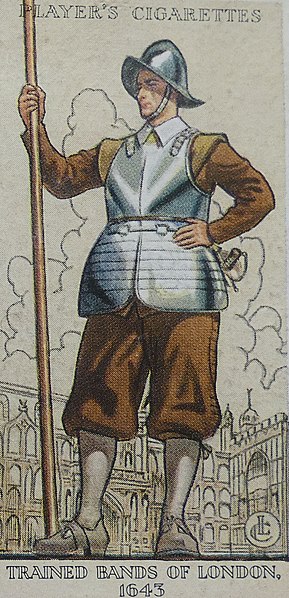The London Trained Bands (LTBs) were a part-time military force in the City of London from 1559 until they were reconstituted as conventional Militia regiments in 1794. They were periodically embodied for home defence, for example in the army mustered at Tilbury during the Armada Campaign of 1588. They saw a great deal of active service during the English Civil War, including the First and Second Battles of Newbury, and the battles of Alton, Cheriton, Cropredy Bridge and Lostwithiel. Throughout their history they were used to suppress civil disorder and insurrection around the capital.
Engraving (not contemporary) of Philip Skippon.
George Vertue's 1738 plan of the London Lines of Communication
Pikeman of the London Trained Bands, 1643
Plan of the First Battle of Newbury.
The First Battle of Newbury was a battle of the First English Civil War that was fought on 20 September 1643 between a Royalist army, under the personal command of King Charles, and a Parliamentarian force led by the Earl of Essex. Following a year of Royalist successes in which they took Banbury, Oxford and Reading without conflict before storming Bristol, the Parliamentarians were left without an effective army in the west of England. When Charles laid siege to Gloucester, Parliament was forced to muster a force under Essex with which to beat Charles' forces off. After a long march, Essex surprised the Royalists and forced them away from Gloucester before beginning a retreat to London. Charles rallied his forces and pursued Essex, overtaking the Parliamentarian army at Newbury and forcing them to march past the Royalist force to continue their retreat.
First Battle of Newbury
Prince Rupert of the Rhine, whose capture of Bristol represented the high-water mark for the Royalist cause
Sir Edward Massie; the Royalist advance on Gloucester was based on the assumption that he would surrender the city, which he did not.
First battle of Newbury site, facing South








